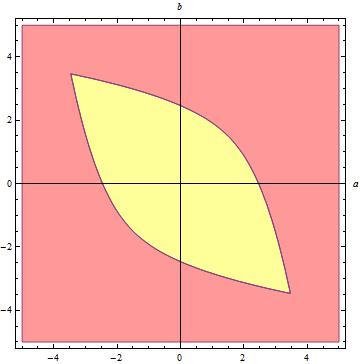Inspired by problem 3, IMO 1973
Let be the set of points for which the above equation has no real root. Area of can be expressed as Find the value of .
Details and Assumptions :
- , are real numbers.
- , , , , and are positive integers, is square free and .
The answer is 59.
This section requires Javascript.
You are seeing this because something didn't load right. We suggest you, (a) try
refreshing the page, (b) enabling javascript if it is disabled on your browser and,
finally, (c)
loading the
non-javascript version of this page
. We're sorry about the hassle.
P ( x ) = x 4 + a x 3 + x 2 + b x + 1 = 0 Let S be the set of pairs of real numbers ( a , b ) at which P ( x ) = 0 has at list one real root. It's immediate that S ′ = A , where S ′ is the complement of set S . We claim that for each point on boundary f of set S like ( a 0 , b 0 ) the equation P ( x ) = 0 has at least one multiple root. Because if all the roots of P ( x ) = 0 at point ( a 0 , b 0 ) be simple, there is a neighborhood of this point where all of roots of P ( x ) = 0 are also simple (Because if changes in coefficients are small enough, changes in roots will be very small as well and they remain simple). Therefore, ( a 0 , b 0 ) would be a interior point of S and not a boundary point of it. So for each point on f , the equation P ( x ) = 0 has at least one multiple root. This conclusion was enough for solving my previous problem ,but here we need more. I want to conclude that we have no simple root on f .
Another point of view for type of roots on boundary is that in fact set A has no boundary. Actually when P ( x ) = 0 has only complex roots, graph of P ( x ) in the x - y plane can approach x -axis most tightly, but it can't touch it. When P ( x ) touches the x -axis we're on the boundary of set S and P ( x ) is tangent to x -axis at some point ( a 0 , b 0 ) , so we have only multiple roots in this point (This is a general rule for problems like this). Now, we want to obtain the shape of f :
Let r = 0 be one of real multiple roots of the polynomial in some point ( a 0 , b 0 ) of f , then P ( x ) = x 4 + a x 3 + x 2 + b x + 1 = ( x − r ) 2 ( x 2 + s x + r 2 1 ) = x 4 + ( s − 2 r ) x 3 + ( r 2 + r 2 1 − 2 s r ) x 2 + ( s r 2 − r 2 ) x + 1 Thus, s − 2 r = a r 2 + r 2 1 − 2 s r = 1 s r 2 − r 2 = b Combining last three relations, one can get s = 2 r 1 ( r 2 + r 2 1 − 1 ) f ( r ) = { a ( r ) = 2 r 1 ( r 2 + r 2 1 − 1 ) − 2 r b ( r ) = 2 r ( r 2 + r 2 1 − 1 ) − r 2 Note that there are no simple roots on f so discriminant of quadratic x 2 + s x + r 2 1 must be less than or equal to zero, this means s 2 − r 2 4 ≤ 0 or: s 2 ≤ r 2 4 4 r 2 1 ( r 2 + r 2 1 − 1 ) 2 ≤ r 2 4 ( r + r 1 ) 2 ≤ 7 2 ≤ ∣ ∣ ∣ ∣ r + r 1 ∣ ∣ ∣ ∣ ≤ 7 Hence we get the domain of f as r ∈ { [ − r ⋆ 1 , − r ⋆ ] ∪ [ r ⋆ , r ⋆ 1 ] } Where r ⋆ = 2 7 − 3 . Let's plot S , f and A

Red part of the graph and the boundary f (black) form set S and yellow part is A where all of the roots of P ( x ) = 0 are complex (why?). Let us use some calculus to find area of A . We have a complete symmetric system for f . Since domain of f is symmetric with respect to origin in parameter space and a ( − r ) = − a ( r ) and b ( − r ) = − b ( r ) we get Area = 2 ∣ ∣ ∣ ∣ ∣ ∫ r ⋆ r ⋆ 1 a ( r ) b ′ ( r ) d r ∣ ∣ ∣ ∣ ∣ (why?). You may integrate above integral to get Area = 4 1 9 2 1 + 5 tanh − 1 ( 7 3 ) We are done.